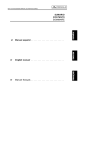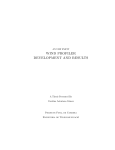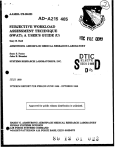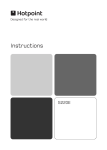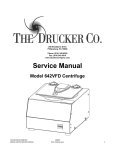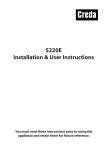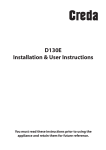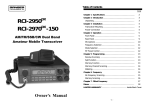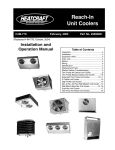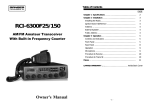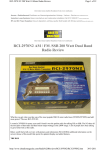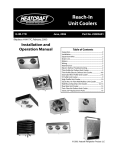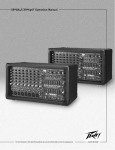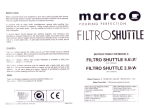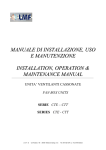Download d o L User`s Manual
Transcript
IREEF1 (Communications, Inc. IR7 1FRINMaM VNiTh1(4!I ITITI1k!L41 Communcations, with Built-in Frequency Counter 867 Bowsprit Road Chula Vista, CA 91914 EmaiI:sa1es@rangerusacom http: //wwwsangerusacom .....................................7. ............... . . . ........ ........................................... .. .... .............. :1 L PRINTED IN TAIWAN PIN:A38251 616A t?85E150 ......... d o L ...................... ' Ranger LIO ....... C I J User's Manual Chapter 1 Specifications Table of Contents ..... . PAGE Chapter 1 Specifications 2 Chapter 2 Installation 3 Installing the Radio................................................................. 3 Ignition Noise Interference.......................................................... 4 GENERAL Model Mode", RC69FF04 Frequency Range : 1. 28,245 - 28.685 MHz 2.28.695 - 29,135 MHz 3, 29.145 - 29.585 MHz 4.28.315 - 28.755 MHz 5. 28.765 - 29205 MHz 6. 29.215 - 29.655 MHz Antenna................................................................................ 4 External Speaker........................................................................ ........................................... 4 4 Public Address.................................. Chapter 3 Operation ............................................................... 5 Controls and Indicators.................................................................................................................. 5 .......................................................................... FrontPanel.. 5 Rear Panel. .........................................................................................................8 ................................................................................ ........ 9 Operation....................................................................... ............................................. ........... Microphone 9 Procedure to Receive............................................................................. 10 Procedure to Transmit................................................................................ I 0 Memo...................................................................................... 11 LIMITED WARRANTY........... .... ............................... ..Inside Back Cover Modes CW/FM!AM!SS8 Frequency Control Phase-Lock-Loop Synthesizer Frequency Stability 0001% Temperature Range -300C to +50°C Input Voltage DCI3.8V Antenna Impedance 50 ohms 7 7/8 (\f 1 x I I 1/8! (D) x 3 114 (H) Size ) Weight Bib 3oz. TRANSMITTER AM/FMICW: 200W, RMS SSB: 400W. PEP Spurious Emissions 50 dB RfPower Output Audio Distortion 10% Frequency Response 300 to 2500Hz Microphone NOTE Amateur Radio License is required to operate this device. For licensing information within the United States of America, visit http//wwwfccgov, for residence of Canada, visit http:llwww.racca Dynamic RECEIVER Sensitivity Squelch Sensitivity Selectivity 614V/AM: 0.5 pVfor 10dB S+N/N FM: 025pV for 12dB S±N/N SSB: 015pV forlOdB S+N/N 0.5 pV 55 dB Image Rejection -50 dB Hum & Noise---------- 40dB Audio Power Output 2.5W at 10% THD (SPECFlCATtDNS SUBJECT TO CHANGE WITHOUT NOTICE) ----------- ------ Chapter 2 Installation Installation - -------------------- (Continued) Installing the Radio 4, Mount the microphone bracket near the radio in an easily accessible spot using the two screws provided. Choose a convenient location for operation that does not interfere with driver or passenger. This radio is supplied with a universal mounting bracket. When mounting the bracket and radio to your car, make sure it is mechanically strong. Also, provide a good electrical grounding connection to the chassis of the vehicle. Proceed as follows to install the radio. 1. Locate a convenient area in your vehicle for the installation of the radio. Hold the mounting bracket with the radio in the location where the radio is to be installed. Make sure nothing will interfere with either the radio or the mounting bolts. Mark and then drill holes for the mounting bracket. 2. Most radio antennas come equipped with a PL-259 plug. Connect this plug to the ANT. Jack in the rear of the radio. 3. Extending from the rear of the radio is a fused red and black wire for the DC connections to the vehicles electrical system. For best performance, it is strongly recommended that the red lead be taken directly to the positive terminal on the vehicles battery and the black lead be connected to the nearest chassis ground. (Note: This radio is designed for vehicles with negative ground systems.) Connections should be made using appropriate "crimp on" lugs of a size large enough to make good contact with the bolt used to fasten to the battery and the chassis ground, It is a good safety idea to install a second fuse, in series with the red wire at the battery connection. This second fuse would provide protection in case the red wire was to 'fray" or get pinched and short to the body of the vehicle, some where between the battery and the radio. High power radios such as this one require large DC current flow when in the TX mode. Poor power connections can cause supply voltage drops that can substantially decrease the performance of your radio. A good DC connection is probably one of the most important things for getting the best transmitter performance and in some cases, least receiver noise. -- _ Ignition Noise Interference With weak signals, you may experience interference of the signal by background noise. This radio has NB and ANL controls which will help reduce background noise from sources such as your ignition system. However, background electrical noise may come from several sources and all noise may not be eliminated. With extremely weak signals, you can operate this radio with the engine turned off, which should improve reception. If the ignition noise level is too high to allow proper operation under most conditions, you should have your installation of the radio checked by a qualified technician. Antenna This radio has a jack in the rear for a standard PL-259 antenna plug. If you are looking for the most range for your transmission, use a vertically polarized, quarter-wave length antenna. If antenna height is a problem, you may use a shorter, loaded-type whip antenna although you can expect some lost of transmission range. To improve performance, your antenna shoud be matched to your radio. Your antenna can be adjusted so that it matches your radio. External Speaker The external speaker jack (EXT. SPK) on the rear panel is used for remote receiver monitoring. The external speaker should have 8 ohms impedance and be able to handle at least 4watts. When the external speaker is plugged in, the internal speaker is disconnected. Public Address To use the Public Address (PA) function, first connect an external speaker to the PA. SP. Jack on the rear of the radio. See the above specifications for a proper external speaker. Keep the speaker away from the microphone to avoid acoustic feedback. Operation (ContinueI Chapter 3 Operation Controls and Indicators 4, MIC GAIN CONTROL: Adjust the microphone gain in the transmit mode. This control is used to set the audio level of the microphone -6. ( 1i ci: 1 9 for maximum performance and clarity. ",......... 5* RF POWER CONTROL: This control enables adjustment of RF power output continuously up to the rated output power. t ................. ...... ( ) . . Ir , . . jn, 'I L I c,i ..4.................... • 6 TALKBACK/OFF CONTROL: Adjust this knob for desired volume of Talkback. This is used to monitor your own voice. Or example, you could use this feature to compare different microphones. 1 in 1 r f . c , 7. Fr. POOL: The Frequency Pool allows the user to select the desired segments of frequencies 0 8. MODE SWITCH: This switch allows you to select one of following operating modes: CW/FMiAMi'LSB/US8 _J4 ) )) Front Panel 1. SQUELCH CONTROL: This control is used to control or eliminate receiver background noise in the absence of an incoming signal. For maximum receiver sensitivity, it is necessary that the control be adjusted only to the point where the receiver background noise is eliminated. Turn fully counterclockwise and then slowly clockwise until the receiver noise just disappears. Any signal to be received must now be slightly stronger than the average received noise. Further clockwise rotation will increase the threshold level that a signal must overcome in order to be heard, Only strong signals will be heard at a maximum clockwise squelch setting. 2. ON/OFF VOLUME CONTROL: Turn clockwise to apply power to the radio and to set the desired listening level. a RF GAIN CONTROL: This control is used to reduce the gain of the RF amplifier under strong signal conditions 9. COARSE/FINE CONTROL: Allows variation of the receiver operating frequency above and below the assigned frequency. Although this control is intended primarily to tune in SSB signal, it may be used to optimize AM/FM signals as described in the operating procedure Oaragraphs. (Coarse and Fine operates both TX/RX). 10 FREQUENCY SELECTOR: This control is used to select a desired transmit and receive frequency. 11. FRONT PANEL METER: The front panel meter allows the user to monitor signal strength and RF power out level. 12 TXIRX LED: The red LED indicates the radio is in the transmit mode. The blue indicates the radio is in the receive mode. 13 FREQUENCY COUNTER: This frequency counter indicates the transmit frequency digitally. 14. ECHO SWITCH: This control is used for echo effect. Operation ( Contin1DJii ...... . ...... - 15 Hi/LOW TONE SWITCH: This switch changes tone quality in receive only. In LO position, bass is increased and in HI position, treble is increased, Operation (Continued) Rear Panel 16 SRF/SWR SWITCH: In the S-RF position, the meter swings proportionally to the strength of the received signal. When transmitting, the meter indicates relative RF output power, When in the SWR position, the Standing Wave Ratio (SWR) of your antenna. There are no adjustment because the SWR circuit in this radio calibrates itself automatically. 17 NB/ANL SWITCH: In the NB/ANL position, the RF Noise Blanker and the automatic Noise Limiter in the audio circuits are also activated The Noise Blanker is very effective in eliminating repetitive impulse noise such as ignition interference. 18. ROGER BEEP SWITCH: When this switch is placed in the ROGER BEEP position, the radio automatically transmits an audio tone at the end of your transmission. This indicates the end of your transmission so that people who are having trouble hearing you will know that you are done speaking. As a courtesy to others, use the Roger Beep only when necessary. 19. +10KHz SWITCH: In the +10KHz position, the transmit and receive frequency is shifted 10KHz up. 20. CHANNEL DISPLAY: The channel display indicates the current selected channel. -7- 2. POWER: This accepts 13.8 VDC power cable with built-in fuse. The power cord provided with the radio has a black and red wire. The black goes to negative and the red goes to positive 3, CW KEY: The CW key is used for Morse Code operation. To operate this mode, connect a CW key to this jack, and place the MODE switch in the OW position. 4, EXTERNAL SPEAKER: This jack accepts a 4 8 ohm, 5watt external speaker. When the external speaker is connected to this jack, the built-in speaker will be disabled. uperation (Continued) LI. . Operation (Continued) "IN - - — ---------- Operation B. Procedure to Receive A. Microphone The receiver and transmitter are controlled by the push-to-talk switch on the microphone. Press the switch and the transmitter is activated, release switch to receive When transmitting hold the microphone two inches from the mouth and speak clearly in a normal "voice" The transceiver comes complete with low-impedance dynamic microphone For best results, the user should select a low-impedance dynamic type microphone or a transistorized microphone. The microphone should provide the functions shown in schematic below. Dhi Ah,mht- I Be sure that power source, microphone and antenna are connected to the proper connectors before going to the next step 2. Turn unit on by turning VOL knob clockwise a Set the VOL for a comfortable listening level. 4. Set MODE switch to the desired operation mode. 5, Listen to the background noise from the speaker. Turn the SO knob slowly clockwise until the noise just disappears. The SQ is now properly adjusted. The receiver will remain quit until a signal is actually received. Do not advance the control too far, or some of weaker signals will not be heard. M;,% (shk Iid sniea Audio Lead Transmit Control Receive Control 1LuaI0 I 2 3 4 6. Set the CHANNEL switch to the desired channel. 7. Set the RF gain control fully clockwise for maximum RF gain. C. Procedure to Transmit 1. Select the desired channel of transmission. 2. Set the MIC GAIN to the level that will best suit your individual use. 3. If the channel is clear, press the push-to-talk switch on the microphone and speak in a normal voice. Transceiver Microphone Schematic Diagram -9- Ranger Communications Limited Warranty Ranger Comniunic.aton, Inc. (Ranger) warrants to the ogna1 purchaser only this product against defects in material or workmanship. as noted below, hli'eeiive December I 2()01 the following Ranger Communications, mrs products ore covered by n two (2) year limited warranty: L Am thur Radio Products. RU 2950DX RC.l 2910 DX RU 29SCWX RCI 2'ThSl)X, RC12990DX, RCI-2995DX, RCI63001`111P. RCI6300FTB. RCI 69()OlHP RCI 69OO!TB R(l 6 )0F25 RU 6 001 150 RU ÔQO()F25 RCI 63001 150 RA 5054DX R(1 5054D\ 100 RU (3 C I C1 631 1 ( 2 RC I 63FFC4, RCJ-69FFCI, RCII69FFC2, RCi69FFC4, RC1-2970N2. 2. Citizens Band Products: TRiOO Series, TR-296 (all models), TR396F, TIR.696F, TR-696F SSB, TR-900 Series (all models). The above products are warranted for the specified time period from the original date of purchase as shown on the original purchasers bill of sale, receipted invoice, or other proof of purchase. After this period, the original purchaser must pay for any labor at the prevailing rate either at an authorized Ranger warranty repair facibty or at the fttctory. In the event of defect during the warranty period, Ranger shall, at its option, repair or replace the defective product. Such action shall constitute the purchaser's exclusive remedy under this warranty. A Return Authorization Nwnher must be obtained from the Ranger Customer Service Department before any returns fbr warranty repair will be accepted. Contact Ranger Communications for Return Authorization at: Ranger Communicaions, Inc. 867 Bowsprit Road Chula Vista, CA 9191.4 Email: salcs(brangerusacom This warranty does not cover cosmetic damage or damage due to acts ofOod, accident, misuse, abuse, negligence, improper installation, lJNAUl1iORIZh'i) MODIFICATION, or any action in violation of the product's instruction manual. This warranty is valid only in the U. S A. 1. 'Limited" means that we will repair problems that are caused by factory defects, only for the above mentioned products and time limit, at no charge. Work performed by qualified technicians which did not cause any damage to the radio wilt not void the warranty, Problems or damage caused by unqualified or misinfomied technicians, operator abuse or other miscellaneous actions may he able to be repaired, but there will be a charge. This warranty is muted to the radio only. 2. Generally, if the warranty sticker is removed or cut:, the radio is considered to he "Void of Warranty". Ilowever, our policy is to he as lenient as we can, and to take this into consideranon.. We will usually repair the radio - under warranty if no abuse or misuse is found, Radios that have parts removed cut or clipped; or the l'CH has been damaged., will not be repaired under warranty. -14-







